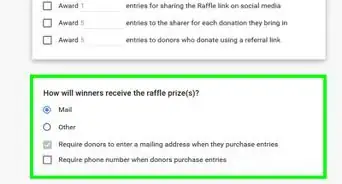This article was co-authored by Rob Wu and by wikiHow staff writer, Christopher M. Osborne, PhD. Rob Wu is the CEO of CauseVox, a digital fundraising platform designed for nonprofits. CauseVox works to help do-gooders raise more money with less effort. Rob has raised over $200,000 for his own nonprofit crowdfunding projects, and his work has been recognized by CNN, Christian Science Monitor, and the Wall Street Journal.
This article has been viewed 56,473 times.
Doing a charity event is a great way to raise awareness and money and bring people together, but the success of the event depends on careful planning and organizing. What exactly does that involve though? Don't worry—we've put together the ultimate guide to planning a fundraising event that will walk you through everything you need to do from start to finish to ensure the event is a hit. Check out the tips below to learn all about the charity event planning process so you can put together a memorable event that meets (or surpasses) your fundraising goal.
Steps
Organizing the Event
-
1Define a clear purpose. While raising money for a good cause is a central component of any charity event, it isn’t always the only (or even sometimes primary) purpose. Once you’ve determined the cause that you want to support, take time to clearly define what your event can do in order to provide the most assistance.[1] [2]
- Generally speaking, there are three types of charity events: direct fundraising, which are indeed focused specifically on raising money; enlistment / profile raising, which aim to attract attention and / or volunteers to the cause; and acknowledgements of support, which are essentially public thank-yous to supporters.
- Every charitable cause needs money, but would your chosen cause benefit at least as much from greater public awareness and support? Tailor your proposed event to best serve the needs of your cause.
-
2Get permission to raise funds or awareness. For legal and practical reasons, it is important to obtain permission before conducting an event to support a charitable organization. The last thing you want to do is draw the ire of the group you’re trying to help, or inadvertently get them in “hot water” through your good intentions.[3]
- Even if you are raising funds for an individual or family — for instance, holding a spaghetti dinner to benefit a family that lost its home to a fire — it is good practice to request and obtain permission first. Most people appreciate charity when in need, but they deserve the right to be involved in and approve of the process.
Advertisement -
3Set a budget and a fundraising goal. It takes money to make money in the business world, and the same is true for raising money for charity. You need to establish a thorough budget before the event so that you can set a realistic fundraising target.[4] [5]
- When setting your budget, take care to account for everything, including the venue, set up, food, entertainment, safety / security, and various other incidental costs based on the nature of your event. It may help to visualize yourself as a guest visiting the event — what would you see, do, and expect, and are those things all covered in your budget?
- Try to set a specific fundraising goal, not just “as much money as possible.” Having a realistic, clear goal will help you plot out your ideal event and can help motivate volunteers and donors to help reach that goal. If you are holding a charity event for an established organization, seek their assistance in determining a reasonable goal.
-
4Identify your target audience. If running a charity event is starting to sound a bit like running a small business, there’s a reason for that. Many of the same principles for budgeting, marketing, logistics, and preparing for the the unplanned hold true whether you are drawing in money for charity or to pay the bills.[6]
- Consider the nature of the cause you are supporting and the potential donor base most apt to come out to support it. If you are raising funds for the local symphony orchestra, for instance, a silent auction and dinner at a country club may be in order. Or, if you are seeking to replace the playground equipment at the local park, a family-friendly street carnival may be your best bet.
- Don’t be overly presumptuous, of course. Make your event welcoming for anyone who wants to support the cause. Simply make sure that the most likely target audience is served.
-
5Establish a theme, design, or focus. Once you’ve determined your goals, budget, donor base, and event type, you can work on the details of crafting your event to ideally represent those factors.[7]
- Again, like a small business, you want to create a consistent “branding” to represent your marketing material and the actual set-up and presentation of the event. Link it to the cause you are supporting. For example, a superhero theme may be a good choice for a fundraiser benefitting a children’s hospital.
- Be creative but budget-friendly, of course. Remember the purpose of the event is to raise money and / or awareness for a good cause.
-
6Attract sponsors. Ideally, your goal should be to have the entire cost of hosting the event covered by sponsorships and donations, so that 100% of the money raised at the event can go to the charitable cause. To make this happen, you need to aggressively but smartly approach potential sponsors with a persuasive "pitch" for your event and their support.[8]
- Business get many requests for sponsorships and donations to charitable causes, so you need to make your effort stand out to improve your odds of success. Don't just rely on the goodness of your cause; make a persuasive case why it will benefit the cause and the supporting business.
- Present a written, detailed proposal that describes items such as: the high-profile media / public / online attention your event will draw in; the high-quality event management team and sensible budget you have assembled; the specific nature of the recognition the company will receive, down to details like banner size and logo inclusions in the program.
- Do some research beforehand on the companies you choose to approach. How many charitable events have they sponsored / supported recently, and at what level? Are there any patterns to the types of events or charities they tend to support? What kind of recognition seems to appeal to them? Come to your meeting as prepared as possible. You may be a volunteer, but act like a professional.
Presenting the Event
-
1Spread the word. There are more options now than ever before in advertising an event, from handing out flyers to engaging in a social media blitz. Use every avenue at your disposal to spread awareness widely, while at the same time paying specific attention to marketing strategies likely to reach your target donor base.[9]
- You can’t really start advertising too early. Begin spreading the word as soon as you have the basics in place (when, where, why), then refine your marketing strategy as you fill in the details.
- Even in today’s digital world, placing posters in the front window of local businesses will help raise awareness of your event. Don’t be afraid to ask for help from local sources in advertising your fundraiser. The same holds true for using social media — accept help whenever and wherever you can.
-
2Don’t shortchange logistics. When you’re in charge of a charity event, your responsibilities can range from ordering tables to booking entertainment to selecting a menu to navigating government red tape. As noted from the beginning of this article, proper planning will make the job of getting what you need (and want) when and where you need it much easier. Good negotiating skills will also prove very useful.[10]
- Many businesses are willing to provide donated items or discounts for charitable events, but they also may get requests all the time and be wary of supporting yet another. Be ready with a good “pitch” for the importance of your cause and the assistance they can provide, and also be ready to negotiate your best deal. Offer more prominent signage thanking them for their donated equipment, for instance, or simply approach multiple vendors to work out your best price.
- The need for government permits or licenses will vary widely based on your location and the nature of your event. If you are offering a raffle or games of chance, selling alcohol, or using public property (a park or a closed-off street, for instance), your odds of requiring government clearance will increase. Contact your local government early in the process to determine what if any permits and licenses you will require.[11]
-
3Assemble your best team. Getting the right volunteers for an event is just as important as getting the right employees for a business. You can’t do it all yourself, and their abilities to get things done will go a long way to determining the success of your event.[12]
- You aren’t likely to have the luxury of being choosy about who your volunteers are, but you can be thoughtful about what roles to place them in. Conduct informal interviews to determine which volunteers are better suited to up-front roles, and which are better for behind-the-scenes work. Be clear to them (and yourself) that every role is critical to the success of the event.
- Depending upon the nature of your event, you may also be utilizing a “host committee,” which is usually a group of large donors and / or local celebrities who are primarily there to add some prestige to your event. Use any advice they may offer judiciously, but also remember that they are only symbolic leaders for the event, while you are the one who needs to be in charge.[13]
-
4Expect the unexpected. No event, charitable or otherwise, goes off without a hitch. Bad weather, a faulty sound system, or even a medical emergency may intervene in your perfectly planned event. You can brainstorm possible problems and solutions to them, but you also need to be flexible enough to “roll with the punches” as your event happens.[14]
- Have a safety plan in place for emergencies, and consider whether you should provide security, especially if the event is open to the public and a large crowd is expected. While probably not required by law, you may want to consider some version of “public liability insurance” as protection against major, unforeseen disruptions.
-
5Follow up after your event. Old-fashioned, handwritten thank-yous can still go a long way in making a donor or volunteer feel special and more willing to help again. Never skimp on showing your appreciation to anyone and everyone who has helped make the event a reality.[15]
- For tax and legal purposes, keep a detailed written record of every donation you receive. You can also use these records as a contact list to keep people informed about and involved in the cause and any future events.[16]
- Always spend some time after the event going through what worked and what did not. Think about what you can learn from this event to make the next one even better. Seek out the opinions of trusted volunteers and donors / supporters.[17]
Expert Q&A
-
QuestionHow do you organize a donation event?
 Rob WuRob Wu is the CEO of CauseVox, a digital fundraising platform designed for nonprofits. CauseVox works to help do-gooders raise more money with less effort. Rob has raised over $200,000 for his own nonprofit crowdfunding projects, and his work has been recognized by CNN, Christian Science Monitor, and the Wall Street Journal.
Rob WuRob Wu is the CEO of CauseVox, a digital fundraising platform designed for nonprofits. CauseVox works to help do-gooders raise more money with less effort. Rob has raised over $200,000 for his own nonprofit crowdfunding projects, and his work has been recognized by CNN, Christian Science Monitor, and the Wall Street Journal.
Fundraising Expert If you want to do a digital fundraising event, start by deciding on your impact and financial goals. First, determine the purpose of raising the funds, which is your impact goal. Then, use that to determine your financial goal. For instance, if you want to help 1000 kids, decide whether you want to raise $50 apiece to provide each one with a backpack full of school supplies? Or is it $100 per kid in order to provide a scholarship so they can go on a field trip? Then, create a narrative. You need to have a compelling reason why your campaign is important, as well as why people should actually pay attention and donate to you. That information will help you craft your marketing for the charity event. Build a campaign site. Your campaign site is basically a page that's optimized for fundraising. It can look like a crowdfunding site, or it can be an event page with more information about the date, location, and purpose of the charity event. Get donations. Try asking your most passionate supporters for donations before anyone else. That can help get people excited. Then, launch the event to the broader public by sending it out on your email list or social media channels. You can also do paid media, PR, or leverage any partners you have to help you spread the word.
If you want to do a digital fundraising event, start by deciding on your impact and financial goals. First, determine the purpose of raising the funds, which is your impact goal. Then, use that to determine your financial goal. For instance, if you want to help 1000 kids, decide whether you want to raise $50 apiece to provide each one with a backpack full of school supplies? Or is it $100 per kid in order to provide a scholarship so they can go on a field trip? Then, create a narrative. You need to have a compelling reason why your campaign is important, as well as why people should actually pay attention and donate to you. That information will help you craft your marketing for the charity event. Build a campaign site. Your campaign site is basically a page that's optimized for fundraising. It can look like a crowdfunding site, or it can be an event page with more information about the date, location, and purpose of the charity event. Get donations. Try asking your most passionate supporters for donations before anyone else. That can help get people excited. Then, launch the event to the broader public by sending it out on your email list or social media channels. You can also do paid media, PR, or leverage any partners you have to help you spread the word.
References
- ↑ http://www.thefundraisingauthority.com/fundraising-basics/fundraising-event/
- ↑ https://www.gov.uk/government/publications/can-do-guide-for-organisers-of-voluntary-events/the-can-do-guide-to-organising-and-running-voluntary-and-community-events
- ↑ http://www.coyotecommunications.com/stuff/events.html
- ↑ http://www.coyotecommunications.com/stuff/events.html
- ↑ https://www.thebiggive.org.uk/advice/how-do-we-market-our-first-charity-event-and-make-it-a-success/
- ↑ http://www.thefundraisingauthority.com/fundraising-basics/fundraising-event/
- ↑ https://www.thebiggive.org.uk/advice/how-do-we-market-our-first-charity-event-and-make-it-a-success/
- ↑ http://www.coyotecommunications.com/stuff/events.html
- ↑ https://www.thebiggive.org.uk/advice/how-do-we-market-our-first-charity-event-and-make-it-a-success/
- ↑ https://www.thebiggive.org.uk/advice/how-do-we-market-our-first-charity-event-and-make-it-a-success/
- ↑ https://www.gov.uk/government/publications/can-do-guide-for-organisers-of-voluntary-events/the-can-do-guide-to-organising-and-running-voluntary-and-community-events
- ↑ https://www.thebiggive.org.uk/advice/how-do-we-market-our-first-charity-event-and-make-it-a-success/
- ↑ http://www.thefundraisingauthority.com/fundraising-basics/fundraising-event/
- ↑ https://www.gov.uk/government/publications/can-do-guide-for-organisers-of-voluntary-events/the-can-do-guide-to-organising-and-running-voluntary-and-community-events
- ↑ http://www.thefundraisingauthority.com/fundraising-basics/fundraising-event/
- ↑ http://www.coyotecommunications.com/stuff/events.html
- ↑ https://www.thebiggive.org.uk/advice/how-do-we-market-our-first-charity-event-and-make-it-a-success/






































































